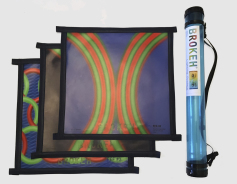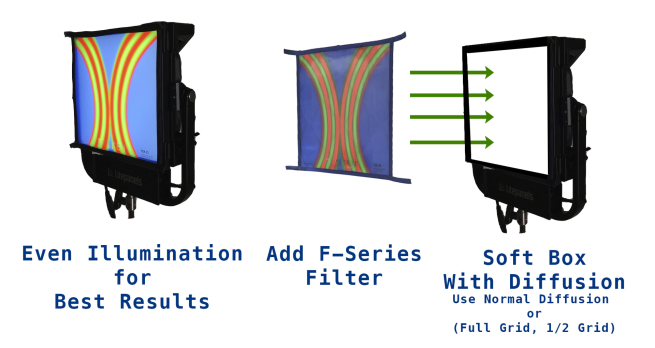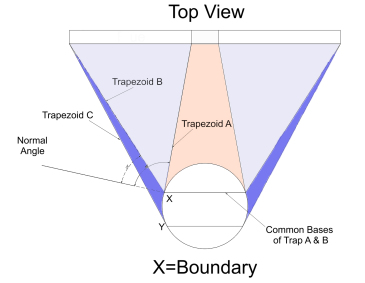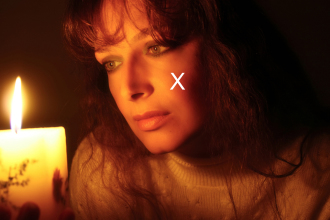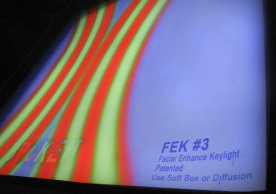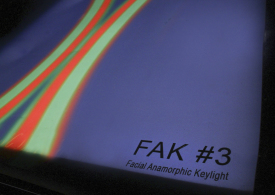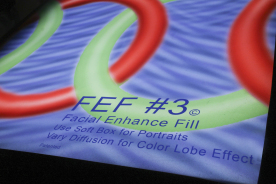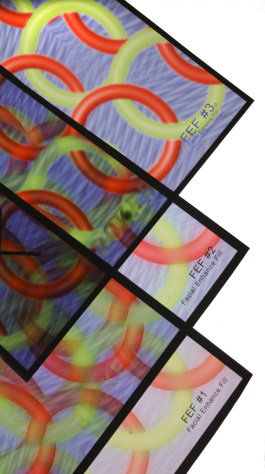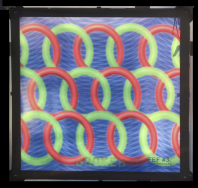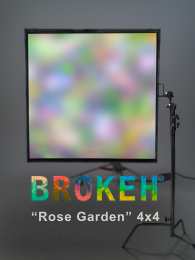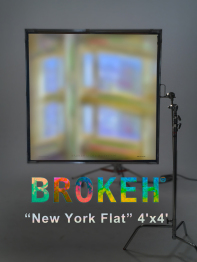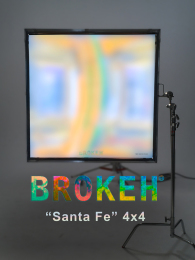Brokeh Technical Information
This is where you will find technical information on Brokeh filters and patterns.
Brokeh is divided into two parts: the Facial Series and the Nature Series
Both Brokeh Series break the white spectrum into different colors that then mix back together on the photographic subject. This gives a much more honest-feeling look than plain flat white light. Although each Series uses different light physics to achieve its effect, they can (and should) be used together on the same set.
Use Facial Series with the diffusion on your soft box (or Full to 1/2 Grid)
The Patented F-Series patterns use the physics of human facial curves and color hues
The curved arcs in the Brokeh pattern interact with the radial curves on your face. In addition, the colors on the pattern are either complementary or dominant facial tones, each having a light or shadow effect on the face.
How can a pattern do that?
The Geometry of Facial Series Brokeh
Humans all share the same skin tones. You may have more or less pigment in your skin but the hues are the same. In this way every face becomes its own contrast filter - the more color you have, the more contouring effect of the Brokeh filter.
The Facial Series uses physics to change the appearance of the human face. It enhances the 3-D qualities of the face by manipulation of illuminator shape and color on a geometric pattern on the soft box skin.
Dominant facial skin tones are arranged on the pattern so that they light the face from a very controlled and specific area (trapezoid A). The remaining areas of the pattern are complementary skin tones and the face absorbs those colors (trapezoids B & C). The key take-away is that the skin only reflects certain parts of the spectrum and that's what Brokeh takes advantage of.
The Brokeh effect is similar to illuminating your face with a nearby candle. The contouring is extreme and the wrap is closely defined by the convex and concave features of the face. This is similar to what the F-Series patterns do with dominant facial colors. So, referring back to the drawing above, point X on the trapezoid is the apex of the model's cheek in the picture on the right.
The Brokeh Facial Series of Patterns
Facial Enhance Key FEK
The FEK is a pattern that is printed onto a transparency material and then coated with dichroic flakes. The curves in the colored arcs interact with the radial curves on the human face to create more depth and contouring. This is a great all-around facial portrait pattern that adds a slight "butterfly" glamour look to faces.
Facial Anamorphic Key FAK
The FAK is an extreme version of the FEF and is designed to change the apparent shape of faces. In addition to the "thinning effect", the FAK and all of the Facial series break apart the many different colors of the spectrum and then mix them on the face to create pearlescent and healthy looking skin.
Facial Enhance Fill FEF
The FEF is a useful fill source but is also good for use as a soft key light. The circles in the pattern interact with the radial curves in the face and create a dynamic shuttering effect when actors move in front of the camera. In addition to dichroic flakes on the front surface, the FEF has an additional special microlens coating on the back surface.
The Facial Series Saturation Grades
The Facial Series uses color saturation based on the original Wratten filter system originally developed by Frederick Wratten and Kenneth Mees in the early 1900's.
A number 5 saturation would be equivalent to a full saturation color tri-pack separation (Wratten #29 Red, 47 Blue, 61 Green). This color pack absorbs a little more than 80% of light transmission.
Brokeh divides that value in to five saturation grades (1-5).
Brokeh #5 = 80% loss (100% of 80%)
Brokeh #4 = 64% loss (80% of 80%)
Brokeh #3 = 48% loss (60% of 80%)
Brokeh #2 = 32% loss (40% of 80%)
Brokeh #1 = 16% loss (20% of 80%)
A Brokeh #5 would absorb too much light, and is actually more color saturation than is needed to achieve facial contouring. The sweet spot is at a #3, with #2 and #1 being useful where you need more light transmission.
But here the plot thickens. The complicating factor is that the "saturation" is derived from the dominant skin tones in the pattern. And those bright colors make up only a small fraction of the surface area of the pattern compared to the complementary (bluish) color's surface area. So to make the overall light coming off the pattern equal white light when mixed together, neutral density is mixed into the bluish area. This causes light loss in excess of what might be expected in a pure Wratten single color filter.
This explains why a given saturation grade in one Brokeh pattern will have different transmission rate in another pattern.
There is a balance between having the pattern contour faces vs. losing light transmission. The goal is to get the job done with as little absorption as possible.
The bottom line is that you don't need to understand how these saturation grades of Brokeh filters are created- you just need to know that a #3 is more saturated and absorbs more light than a #1 in a particular pattern.
| Pattern | Saturation | Transmission | f Stop Loss |
Because the Brokeh saturation grades are based on a smaller surface area, each pattern has different transmission rates. Transmission rates within individual patterns follow a more predictable transmission gradient.
The table to the left describes the light transmission of the current Facial Series patterns. |
| FEK | #3 | 37% | -1 1/3 | |
| FAK | #3 | 25% | -2 | |
| FEF | #3 | 38% | -1 1/3 | |
| FEF | #2 | 45% | -1 1/6 | |
| FEF | #1 | 50% | -1 |
Tricks with the FEF Pattern
FEF (Facial Enhance Fill) (Shown left) The FEF is part of the trilogy of Facial patterns and when lighting portraits, you should use it on a light box or in front of diffusion (1/2 grid or your choice) that will hold the light and make it even.
However the FEF is special and has a special diffusion built in for throwing colors using hard lights (Fresnels). Hang the FEF on the barn doors or on a C-Stand a distance away from the fixture and create interesting color modulating backlights or other effects to break up monochromatic lighting. By adding light diffusion to the light source you can soften and change the pattern. John Tindall call this "color lobe lighting" where you project different colored curved sheets of light into your set. Then when actors pass through the set there is modulation creates a sense of geography.
The Nature Series
The Brokeh Nature Series uses separation of color fields to create realistic looking light
Brokeh Nature Series "Rose Garden" Pattern
This pattern is designed to offer realistic ambient lighting with undetectable reflections in shiny objects. Use on a frame as either a bounce source or a diffuser.
Good for dramatic narrative filming and natural-looking lighting in day or night applications.
Available for sales in 4'x4' and 6'x6' on Magic Cloth* or Brokehlite
Also in studio leasing in 8'x8', 12'x12' and custom sizes.
Brokeh Nature Series "New York Flat" Pattern
This pattern is designed to offer realistic ambient lighting with undetectable reflections in shiny objects. Use on a frame as either a bounce source or a diffuser.
Good for dramatic narrative where you want the illusion of being inside a room lit by windows or even urban street fill.
Avalible for sales in 4'x4' and 6'x6' on Magic Cloth* and soon on BrokehLite
Also in studio leasing in 8'x8', 12'x12' and custom sizes.
Brokeh Nature Series "Santa Fe" Pattern
This pattern is designed to offer realistic ambient lighting with undetectable reflections in shiny objects. Use on a frame as either a bounce source or a diffuser.
Santa Fe has become a favorite for lighting portraits. It is great for narrative or portrait use.
Available for sales in 4'x4' and 6'x6' on Magic Cloth* and BrokehLite
Also in studio leasing in 8'x8', 12'x12' and custom sizes.
*The Nature Series paterns on Magic Cloth are specially printed so that either bounce or backlight diffused lighting has the same effect on the photographic subject. Light with sunlight bounce until dusk and then push HMIs through the back of the Nature pattern and continue with your scene.

